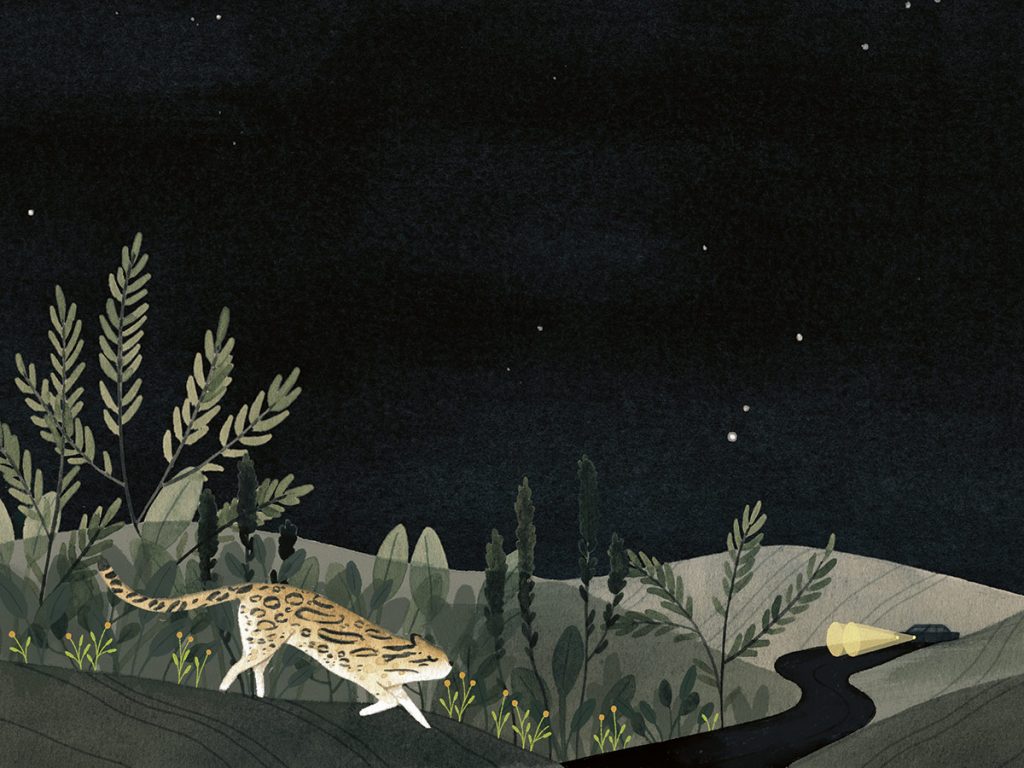The Dispossessed
In South Texas, the ocelot (Leopardus pardalis) has become an unfortunate mascot for the consequences of dramatic habitat destruction. Not much larger than a Maine coon house cat, nocturnal and elusive, the subspecies albescens has lost more than 95 percent of its habitat in Texas, where the last two breeding populations in the U.S. remain. It is very rare today for human eyes to behold firsthand the distinct barred-and-spotted coat, unique rounded ears and striking lined eyes of this cat in the wild. There are only 50 to 55 known individuals in Cameron and Willacy Counties and fewer than 80 estimated remaining in all of Texas. Their preferred habitat is the dense, shady Tamaulipan thornscrub of the lower Rio Grande Valley and Plains, and they are unlikely to venture into more open spaces. Even the teams of biologists dedicated to learning about, tracking and protecting these animals have made many of their observations via wildlife cameras.
When asked about recent news coverage of a rebound in ocelot populations, wildlife biologist Dr. Hilary Swarts politely interrupts — “There’s no population rebound,” she says. “We’re optimistic to see kitten births by camera, but our baseline population is about 15 individuals. I’m optimistic because they are breeding; it means we have good conditions … but ultimately, they are space limited.” Habitat loss has been the biggest blow to U.S. ocelot populations, and habitat restoration is one of the highest barriers to bolstering their numbers.
“People ask why we don’t have a captive breeding program, but that’s not the problem; these cats make more cats — we just don’t have anywhere to put them!” says Swarts, who heads the Ocelot Monitoring and Recovery Program at Laguna Atascosa National Wildlife Refuge. Though spoken with a light tone (in a climate where preserving one’s sense of humor is an admirable endeavor), her words also hold the weight of truth. Thick thornscrub with a lot of canopy cover is the obligate habitat of the ocelot, and each mature cat requires enough range for hunting and finding water, meeting a mate, and (for females) preparing a den for their litter.
Composed of mixed brushy species, the thornscrub habitat includes such native plants as spiny hackberry (Celtis ehrenbergiana), lotebush (Ziziphus obtusifolia), amargoso (Castela erecta ssp. texana), cenizo (Leucophyllum frutescens) and elbowbush (Forestiera pubescens) interspersed with mesquite (Prosopis spp.), Texas ebony (Ebenopsis ebano) and other native trees. The thick, thorny growth is easily navigated by the small, sleek feline, and it also supports deer, javelinas, quail and other resident and migratory birds, totaling over 400 species (not including insects). Swarts notes that the plants “produce a ton of fruits and seeds for rodents, birds, reptiles and insects that are great prey species for ocelots, bobcats and coyotes. It’s an incredibly rich and productive habitat; it just doesn’t gel very well with humans.”
Humans, largely occupied with access and agriculture, have a hard time finding a use for thornscrub areas, making education about the ecosystem services they provide an important aspect of the work being done by conservation groups. The Texas Parks and Wildlife Department and U.S. Fish and Wildlife Service (USFWS) also face the challenge of restoring Tamaulipan thornscrub, a task made much more daunting by invasive species such as Guinea grass (Urochloa maxima), which move in quickly and choke out the otherwise diverse shrubs and understory, complicating the already slow and tedious process of re-establishing thornbrush species.
Add to the list of ocelot woes the problem of accessing the available habitat. Though federal, state and independent conservation groups may purchase land or partner with generous private landowners to preserve viable ocelot habitat, connecting those plots with safe, covered corridors the animals will utilize is a herculean task. “Habitat loss and fragmentation are really the longterm challenges, the immediate consequences of which are [ocelots’] other main challenges,” Swarts says, referring to a distressing vehicle mortality rate and a loss of genetic diversity for the cats.
From June of 2015 to April of 2016, seven cats were known to be killed by motorists. Swarts says a conservative estimate is that 50 percent of known ocelot mortalities are caused by vehicles. With rapid urban growth, industrial transport and tourist traffic (many a spring breaker has taken state Highway 100 through ocelot territory to South Padre Island), a partnership with Texas Department of Transportation is a last hope for addressing the need for safe wildlife passage. A series of fences and underpasses are being put in expressly to address the ocelot condition (with the intention that other wildlife will benefit from utilizing them as well). Monitoring and time will tell, but Swarts is leaning into the project: “Every cat matters; every loss is not just of an individual, but their genetics.”
Therein lies the nearly invisible blow to ocelots that comes with dwindling habitat, access and population: disappearing genes. With few breeding females, limited access to mates and no natural connectivity with other breeding populations at present, “genetic bottlenecking,” as Swarts puts it, could become a real problem for the remaining wild population of ocelots in Texas. There is hope that USFWS can work with partners in Mexico to translocate a female from a population of the same subspecies south of the border, making way for genetic diversity. “In a dream world,” Swarts says, “everything is connected and these ocelots can make the choice to make that exchange.” In reality, because the habitat is so slow-growing and land acquisition may not be enough to create dense, natural corridors, manual translocation may have to be implemented while the land catches up. It’s clear that ocelots won’t be living in a dream world any time soon — but hopefully we can help keep them alive in this one.


